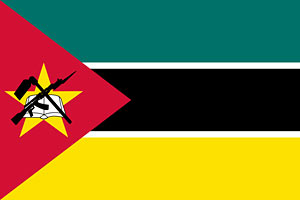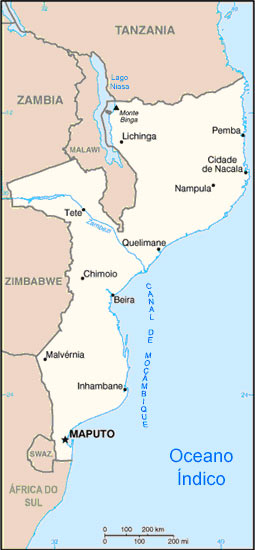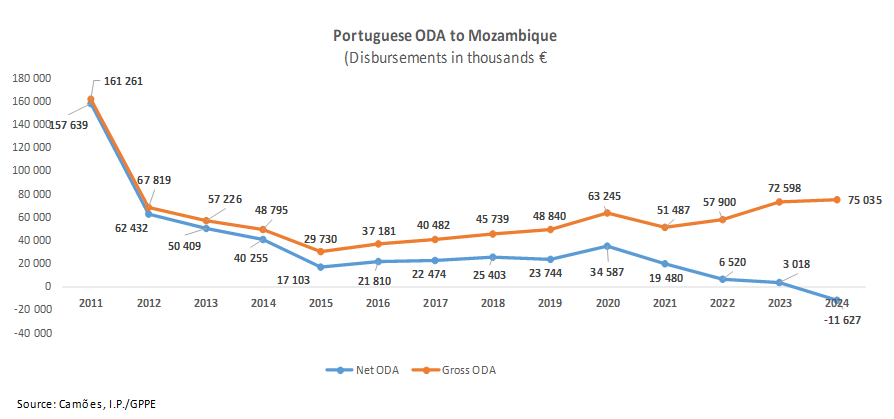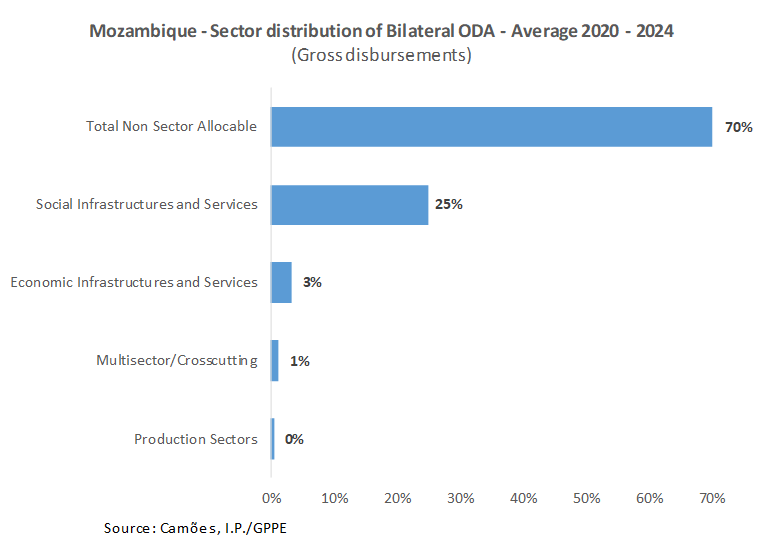Co-operation relations between Portugal and Mozambique
Dados Gerais
D esignação Oficial: República de Moçambique
esignação Oficial: República de Moçambique
Presidente da República: Filipe Nyusi (2015)
Primeiro-Ministro: Adriano Maleiane (2022)
Data de Independência: 25 de junho de 1975
Capital: Maputo
Províncias: Cabo Delgado, Gaza, Inhambane, Manica, Maputo, Nampula, Niassa, Sofala, Tete e Zambézia
Línguas: Português (oficial); 13 línguas principais: Emakhuwa, Xitsonga, Ciyao, Cisena, Cishona, Echuwabo, Cinyanja, Xironga, Shimaconde, Cinyungue, Cicopi, Bitonga e Kiswahili.
Religiões: Animista, Cristã (Católica e Protestante), Islâmica e Hindu.
 Informação Geográfica
Informação Geográfica
Área: 799 390 Km2 (13 000 Km2 de águas territoriais)
Clima: Tropical / Subtropical
Informação Demográfica
População: 32,5 milhões de habitantes (2023-CIA, World Factbook, est.)
População Rural: 61,2% (2023-CIA, World Factbook)
População Urbana: 38,8% (2023-CIA, World Factbook)
Taxa de Crescimento Anual da População: 2,55% (2023-CIA, World Factbook, est.)
Esperança de Vida: 59 anos (2021-BM)
Taxa de Alfabetização de Adultos (15 anos e mais): 63% (2021-BM)
Índice de Desenvolvimento Humano: 185.ª posição (2021-PNUD)
Informação Económica
Unidade Monetária: Novo Metical – Mtn (desde 1 de julho de 2006)
PIB per Capita: 551 USD (2023-AICEP, est.)
Taxa de Inflação Média: 10,3% (2023-AICEP)
Taxa de Crescimento real do PIB: 4,1% (2021-AICEP, est.)
Exportações Portugal-Moçambique: 223 milhões de euros (2022-AICEP)
Importações Portugal-Moçambique: 59 milhões de euros (2022-AICEP)
Investimento Direto Português: n.d.
Principais Investidores: n.d.
Outros Dados
Embaixada de Portugal em Maputo
Embaixador: António Costa Moura (desde 2021)
Morada (Embaixada): Avenida Julius Nyerere, n.º 720 - 12.º andar, Caixa Postal 4696, Maputo
Telefones: (+258) 21 490 316 / 322 / 319
Fax: (+258) 21 491 172
E-mail:
Adido para a Cooperação: Patrícia Pincarilho
Embaixada da República de Moçambique em Lisboa
Embaixador: Joaquim Simeão Bule
Morada (Embaixada): Avenida de Berna, n.º 7, 1050-036 Lisboa
Telefone: 217 971 994
E-mail:
Site: http://www.mozambique.mz
Ponto de situação

Enquadramento Geral
As relações de cooperação entre Portugal e Moçambique refletem o bom relacionamento político existente entre os dois países e assentam numa matriz cultural, jurídica e institucional comum e de competências técnicas específicas em áreas fundamentais para o desenvolvimento. Neste sentido, a partilha de uma língua comum permite um mais fácil enquadramento da intervenção da Cooperação Portuguesa em Moçambique.
Neste contexto, a cooperação institucional entre os dois Estados tem vindo a desenvolver-se quer no contexto bilateral, através dos Programas Estratégicos de Cooperação (PEC), consubstanciados em programas e projetos propostos e executados anualmente com a colaboração de ministérios setoriais, autarquias e sociedade civil, em particular das (ONGD) portuguesas, quer no contexto multilateral, em articulação com outros parceiros de cooperação, no qual se incluem os programas da União Europeia, como os da cooperação delegada, para os quais Portugal também contribui enquanto Estado Membro, e das agências especializadas do sistema das Nações Unidas.
- Adenda ao memorando de Entendimento entre o Governo da República Portuguesa e Governo da República de Moçambique
- Programa Estratégico de Cooperação Portugal-Moçambique 2017-2021
- Programa Estratégico de Cooperação Portugal-Moçambique 2022-2026
Programa indicativo da cooperação
Programa Indicativo de Cooperação Portugal: Moçambique 2011-2014
Co-operation in Numbers
Portuguese Official Development Assistance to Mozambique
A significant part of Mozambique's ODA corresponds to the use of concessional credit lines to finance infrastructure and projects included in the country's development program. The difference between net and gross amounts is explained by the debt forgiveness that takes place every year. In 2024, as in 2023, Mozambique was the largest recipient of Portuguese ODA, receiving 75M€ in gross ODA, an amount justified in part by the debt forgiveness of 52M€.

On average, non-sector allocable aid constitutes the most significant portion of gross ODA, 70%, due to the use of a concessional credit line and annual debt forgiveness. The weight of the “Social Infrastructure and Services” grouping is also significant (25%) due to support for the “Education” (Higher Education), “Health” (donation of vaccines and support to combat the COVID-19 pandemic), “Culture”, “Housing” and “Employment Creation” sectors.






